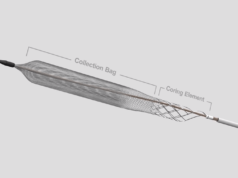
A recently-published study concludes that three-dimensional (3D) computed tomography venogram (CTV) enables accurate diagnosis and treatment of patients presenting with symptomatic chronic iliofemoral venous obstruction (CIVO).
Writing in the Journal of Vascular Surgery: Venous and Lymphatic Disorders, authors Arjun Jayaraj and Seshadri Raju (St Dominic Hospital, Jackson, USA) note that the last several years have witnessed an increase in the diagnosis and treatment of CIVO. “While intravascular ultrasound [IVUS] has become the gold standard in the management of CIVO,” they begin, “it is an invasive technique”.
In order to ascertain the utility of noninvasive imaging technology in the diagnoses and treatment of CIVO, the investigators compared 3D reconstructions from CTV to IVUS.
A total of 22 continuous patients who underwent IVUS interrogation during intervention for CIVO formed the study cohort. Patients who had stenting performed in the setting of chronic total occlusion of the iliofemoral segment or acute iliofemoral deep venous thrombosis were excluded.
Jayari and Raju write that all patients underwent CTV as part of their standard preoperative work up. Minimal (smallest) luminal areas of the common iliac, external iliac, common femoral veins, and the inflow channel were obtained from 3D CTV and IVUS.
In addition, centerline length measurements were obtained from 3D CTV to estimate length of the venous stents necessary while the inflow channel luminal area was used to predict the required stent diameter.
The authors report that Pearson correlation statistic for luminal areas between 3D CTV and IVUS for the common iliac veins was 0.89 (p<0.01), for the external iliac veins was 0.77 (p<0.01), and for the common femoral veins was 0.69 (p<0.01).
Furthermore, sensitivity was 69%, 57%, and 86%, respectively, in the common iliac, external iliac, and common femoral vein segments.
Jayari and Raju detail that positive predictive value of 3D CTV in determining CIVO in the common iliac, external iliac, and common femoral vein segments were 89%, 83%, and 92%, while negative predictive value was 100%, 100%, and 67%, respectively.
In terms of overall accuracy, this was 91%, 86%, and 82% in the common iliac, external iliac, and common femoral vein segments and that 3D CTV is able to predict stent length within 9.5mm of the actual stent length used.
Finally, with respect to stent diameter, 3D CTV was able to predict within 2mm of the actual stent diameter used 91% (20/22) and within 4mm of the actual stent diameter used 100% (22/22) of the time.
Jayari and Raju conclude that from a diagnostic standpoint 3D CTV does well with an overall accuracy ranging from 82% in the common femoral vein going up to 91% in the common iliac vein in predicting CIVO. They add that it is also able to accurately predict venous stent diameter and lengths required “rendering it a good tool in the diagnosis and treatment of symptomatic chronic iliofemoral venous obstruction”.









